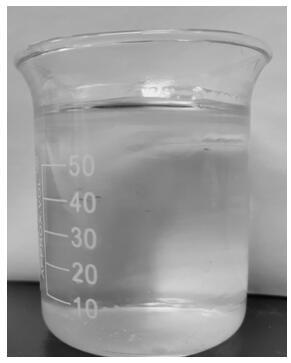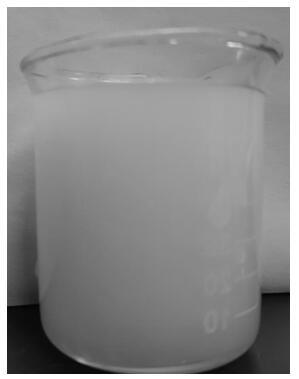Preparation method of silicon-containing softening agent for facial tissue and application thereof
A technology of softener and facial tissue, applied in textiles and papermaking, improved handle fiber, fiber treatment, etc., can solve the problems of whiteness, water absorption, poor decontamination, cost increase, serious problems, etc., and achieve excellent smooth feel, Improvement of yellowing and stabilization of softener
- Summary
- Abstract
- Description
- Claims
- Application Information
AI Technical Summary
Problems solved by technology
Method used
Image
Examples
Embodiment 1
[0028] Step (1): Weigh 6 parts of amino-modified silicone oil and 30 parts of distilled water into a three-necked flask, and stir in a water bath.
[0029] Step (2): compound emulsifier: add fatty alcohol polyoxyethylene ether, alkylphenol polyoxyethylene ether and fatty alcohol surfactant in a certain weight ratio (2:2:1) to the beaker.
[0030] Step (3): Add the emulsifier in step (2) into the amino-modified silicone oil, and stir until evenly dispersed.
[0031] Step (4): Then quickly drop 0.25 parts of glacial acetic acid solution while stirring the solution, and then add 8 parts of glycerin after the dropping, and react for half an hour to obtain a silicon-containing softener.
Embodiment 2
[0033] Step (1): Weigh 6 parts of amino-modified silicone oil and 33 parts of distilled water into a three-necked flask, and stir in a water bath.
[0034] Step (2): compound emulsifier: add fatty alcohol polyoxyethylene ether, alkylphenol polyoxyethylene ether and fatty alcohol surfactant in a certain weight ratio (3:3:1) to the beaker.
[0035] Step (3): Add the emulsifier in step (2) into the amino-modified silicone oil, and stir until evenly dispersed.
[0036] Step (4): Then, while stirring the solution, quickly add 0.3 parts of glacial acetic acid solution dropwise, and then add 8 parts of glycerin after the dropwise addition, and react for half an hour to obtain a silicon-containing softener.
Embodiment 3
[0038] Step (1): Weigh 7 parts of amino-modified silicone oil and 36 parts of distilled water into a three-necked flask, and stir in a water bath.
[0039] Step (2): compound emulsifier: add fatty alcohol polyoxyethylene ether, alkylphenol polyoxyethylene ether and fatty alcohol surfactant in a certain weight ratio (3:3:1) to the beaker.
[0040] Step (3): Add the emulsifier in step (2) into the amino-modified silicone oil, and stir until evenly dispersed.
[0041] Step (4): Then quickly dropwise add 0.35 parts of glacial acetic acid solution while stirring the solution, and then add 9 parts of glycerin after the dropwise addition, and react for half an hour to obtain a silicon-containing softener.
PUM
 Login to View More
Login to View More Abstract
Description
Claims
Application Information
 Login to View More
Login to View More - R&D
- Intellectual Property
- Life Sciences
- Materials
- Tech Scout
- Unparalleled Data Quality
- Higher Quality Content
- 60% Fewer Hallucinations
Browse by: Latest US Patents, China's latest patents, Technical Efficacy Thesaurus, Application Domain, Technology Topic, Popular Technical Reports.
© 2025 PatSnap. All rights reserved.Legal|Privacy policy|Modern Slavery Act Transparency Statement|Sitemap|About US| Contact US: help@patsnap.com



